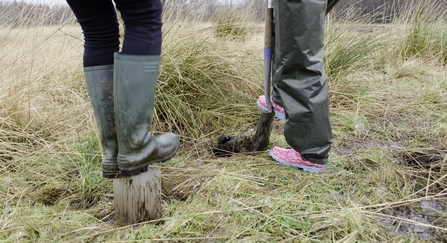
WildNet - Amy Lewis
Wildlife Gardening Tips for November
Dig a wildlife pond
Creating a wildlife pond is the best thing you can do for wildlife in your garden or outdoor area. They provide breeding places for amphibians and homes for numerous invertebrates, which in turn encourage other wildlife such as bats and birds. It is also beneficial to your garden, as Frogs, Toads and Newts all eat slugs! To create your own, follow the steps below:
- Find a sunny area of flat ground, away from too much shading. This will provide the ideal conditions for wildlife in the pond and allow essential oxygenating plants to grow.
- Decide on the size and shape of your pond. Irregular edges are best as they create many different micro-habitats with areas of different depth, shade and temperature. The most important thing with a wildlife pond is that a variety of depths are provided, with lots of shallow areas and the sides gently slope to the deepest point. If space is limited, you can
just create one sloping side. A deeper zone of over 60cm is perfect for over-wintering species. From this plan, decide how much liner you need. We recommend butyl rubber as it is cheap, easy to use and does the job well. To work out how much you need use the following formula: Width + (2 x max depth) x Length + (2 x max depth). - Start digging! Dig a trench out around the edge of your pond that you can bury the edges of the liner in for a neat finish.
- Once you have dug out your pond shape, remove any sharp stones and line the hole with old newspaper, carpet or similar material to protect your liner. Unroll the liner – let overhanging edges fall into the trenches.
- Add a layer of sand as substrate for plants and animals.
- Place stones and logs around the edge of your pond to create shelter for future visitors.
- Now you can just sit back and wait for the rain to fill your new pond!
- To support as much wildlife as possible, plant your pond with native pond plants. A suggested (but not exhaustive) list is provided here.
Avoid adding fish to your pond as they eat many pond-dwelling invertebrates. Fountains are also not recommended as the mechanism can be deadly for invertebrates.
Recommended native plants include:
- Water Starwort (Callitriche stagnalis) – favoured by newts for egg-laying
- Yellow Flag Iris (Iris pseudacorus) – provides upright stems for dragonfly and damselfly emergence
- Spiked Water Milfoil (Myrophyllum spicatum) or Potamogeton species – submerged plants for oxygenation
- Bog-bean (Menyanthes trifoliata) – pretty and creates floating mats for egg-laying dragonflies
Plants to avoid at all costs include:
- New Zealand Pygmyweed (Crassula helmsii)
- Parrot’s Feather (Myrophyllum
- aquaticum)
- Water Fern (Azolla filiculoides)
- Floating Pennywort (Hydrocotyle
ranunculoides)

© Katrina Martin / 2020VISION
